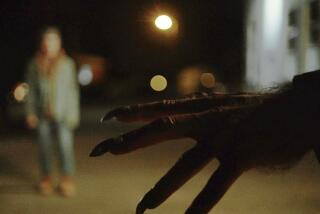‘The Wolfman’
- Share via
Here’s the surprise of the new incarnation of “The Wolfman,” starring Benicio Del Toro -- there isn’t one. No bite either, or humor, or camp. And the real killer . . . almost no spine-tingling dread. So I guess this is a kind of a horror story after all.
Also starring, and squandering, the talents of Anthony Hopkins, Emily Blunt and Hugo Weaving, the film is built around the ancient myth of the cursed creature -- part man, part wolf, part of the time -- who battles to control the monster he discovers inside. But if you think the wolfman is conflicted, that’s nothing compared with the filmmakers.
When it comes to creating a horror movie, there is always that critical first fork in the road: Do you go with intellect and irony, like the recent “Sherlock Holmes” for example, or opt for camp like the “Scream” series, or try for grown-up terror like “The Exorcist,” or teen terror à la“Friday the 13th,” or descend into the torture porn of “Hostel” or “Saw”?
If you do it well, it doesn’t much matter which path you choose, but you do need to choose, and there’s no indication that director Joe Johnston ever did. I’m sure it didn’t help that Johnston came to the party late after director Mark Romanek left just before filming started for murky reasons that remain more of a mystery than anything on screen. The story he inherited uses Curt Siodmak’s script of the classic 1941 “The Wolf Man” as a foundation, with Andrew Kevin Walker (“Se7en”) and David Self (“Road to Perdition”), two guys who should know their way around dark drama, brought in to thicken the plot.
Set among the dark moors, decaying estates and gypsy curses of 1890s England, “The Wolfman” is a re-imagining of old-fashioned horror of a type that existed long before it would become a rich revenue vein that Hollywood has since strip-mined. That may be partly why the film has no teeth.
In the new telling, Del Toro’s Lawrence, a British nobleman’s son, has been living in the States with his aunt since the childhood trauma of seeing his mother with her throat slashed. Now grown, he’s an actor starring in the road tour of some play when news of his brother’s disappearance reaches him.
Del Toro’s dark brooding looks and heavy brows do work to his advantage, though little else does. (You have to wonder if the U.S. auntie and the acting gig were contrived to cover that he’s the only major figure in the cast without a passable British accent.)
Lawrence gets the bad news in a letter from his brother’s fiancée, Gwen (Blunt), and returns to the home of his birth, a cobweb-covered manse near a town called Blackmoor, where his father, Sir John (Hopkins), and his Indian servant, Singh (Art Malik), still live.
Though Lawrence seems to have a good head on his shoulders, he heads out late one night for a nearby encampment of gypsies because that’s where any wolfman investigation always starts. But guess who’s coming to dinner? There’s a major battle, entrails are scattered everywhere -- the gore will be too little for some, too much for others -- Lawrence is wounded, and before you know it he’s struggling with his primal urges.
The rest of the film unfolds in both predictable and problematic ways. The father-son issues between Lawrence and Sir John, a key piece of the puzzle here, are mostly tedious. The insane-asylum scenes (don’t ask) get lost in trying to make some kind of social statement about how barbaric the 1890s were. And I won’t even bore you with the Gwen-Lawrence love story because the movie will take care of that for me.
But, you’re asking, what about the actual “wolfman?”
Well, cool special effects from master effects maker Rick Baker as man transmogrifies into wolf -- a painful process with bones, teeth and hair growing crazy fast. The director metes out the image in small doses, I guess trying to inject surprise into the proceedings, starting with just a whoosh and a blur. Then it’s fingers into claws, teeth into fangs, then legs into wolf-legs?
When the beast is finally revealed, he’s fearsome. Too bad the story’s not.
More to Read
Only good movies
Get the Indie Focus newsletter, Mark Olsen's weekly guide to the world of cinema.
You may occasionally receive promotional content from the Los Angeles Times.








